Future Remains Unclear Despite Trump-Kim Agreement – OpEd
By Arab News
By Dr. Theodore Karasik*
The historic Singapore meeting between US President Donald Trump and North Korea’s Kim Jong Un resulted in a new phase of relations previously thought impossible. Trump is allowing the hermit kingdom to break out of its shell.
Importantly, Trump committed to providing security guarantees to North Korea, while Supreme Leader Kim reaffirmed his firm and unwavering commitment to the complete denuclearization of the Korean Peninsula. The two leaders also ratified the April 27, 2018, Panmunjom Declaration, in which North Korea commits to working toward denuclearization. The leaders also committed to establishing new Washington-Pyongyang relations and agreed to join their efforts to build a lasting and stable peace regime on the Korean Peninsula. Both countries also agreed to recover the remains of soldiers who were prisoners of war or were missing in action during the Korean War, including the immediate repatriation of those already identified. This is an important part of closing the conflict, which has been technically ongoing despite the signing of an armistice in 1953.
But the future remains unclear: The two sides did not reach any agreement on the details of how to achieve or verify that denuclearization. Details concerning the verification still need to be worked out. North Korea, which destroyed a testing site a few weeks ago, still has many steps to go through to achieve denuclearization — a process that will take years and which also needs to include provisions regarding missile technology. Trump also announced the end of US-South Korean wargames that the North sees as a threat. This was seen by many as a mistake, as it meant he was giving in to Pyongyang.
While the political fallout of the Trump-Kim meeting will unfold in the coming days and weeks, the moment when the leaders shook hands had an immediate impact on many. The potential end of South Korea-US military exercises is worrying to US lawmakers and some South Korean politicians. Notably, Seoul may very well see some of its security guarantees from the US shifting dramatically, leading to instability surrounding its security requirements during this time of transition on the Korean Peninsula. The dismantling of North Korea’s nuclear program — which could take a decade — still needs to be negotiated in a long process that will challenge everyone.
Nevertheless, there are rays of sunshine for the Korean people who, for the most part, feel it is time for America to leave the peninsula in peace. Reunification is now a key word that keeps popping up. The moves toward “reconciliation” are feeding the ongoing discussions between Kim and South Korean President Moon Jae-in about their own bilateral relations. “Reconciliation” and “unification” are key concepts that are being discussed by powerbrokers, policy-makers and businesses. The seriousness of the conversations are raising issues of means, methods and a timescale for achieving such a feat in the wake of the historic Singapore summit.
Eager for reconciliation, 53.8 percent of South Koreans believe that reunification is necessary, according to a 2017 Unification Perception Survey conducted by Seoul National University’s Institute for Peace and Unification Studies. However, due to the tense relations between the two sides, only 2.3 percent of South Korean respondents believed it was possible “within five years,” while 13.6 percent thought it would happen “within 10 years.”
Reunification is not simple and no model will be perfect. One option is the so-called “one country, two systems” arrangement, similar to China’s relationship to Hong Kong. However, the North Korean leader knows that a controlled process will need to be maintained to avoid a flood of people, information and investment entering North Korea. State-controlled companies will dominate the landscape, looking for foreign companies that can help the process of opening up to South Korea and the outside world. That race may be complicated by other external actors — China, Russia and the US — who are all looking at the economic pie of an open North Korea.
In the wake of the Singapore summit, China’s role in the reunification process should not be underestimated. Korea’s major trade partners would experience a substantial increase in GDP and employment through Korean reunification. Beijing would benefit the most, especially based on the healthy relationships built between the locals of China and North Korea. Han Chinese, Korean-Chinese (Chosunjok) and Chinese-North Koreans are uniquely positioned to interact with North Korean firms and give Beijing a competitive edge and influence. Trans-border interconnectivity at the local level will be key to building bridges and helping reunification.
Notably, the Singapore summit allows North Korea’s leader to move forward on opening special economic zones, mineral extraction, casinos, and a ski resort. If the reunification of Korea is achieved, both sides can benefit from the connectivity offered by China’s One Belt One Road Initiative. China would be the stabilizing factor in any reunification process. Behind Beijing is Russia, which is eyeing rail and pipeline infrastructure projects as part of reunification that could bring financial benefits to both Pyongyang and Moscow.
Overall, the Trump-Kim summit and agreement to restructure US-North Korean relations is a positive development. The ability to de-escalate tensions on the Korean Peninsula is a benefit to everyone. “Trust” and “verify” will become key words in this ongoing process.
Koreans have heard talk of unification before. Over the decades there have been periods of upbeat moods on the issue, only for hope to be dashed by broken promises within a year or less. North Korea’s Juche ideology, or self-reliance, is engrained and will be tough to transform. Nevertheless, the Singapore summit is a very serious step forward.
*Dr. Theodore Karasik is a senior adviser to Gulf State Analytics in Washington, D.C. He is a former RAND Corporation Senior Political Scientist who lived in the UAE for 10 years, focusing on security issues. Twitter: @tkarasik

